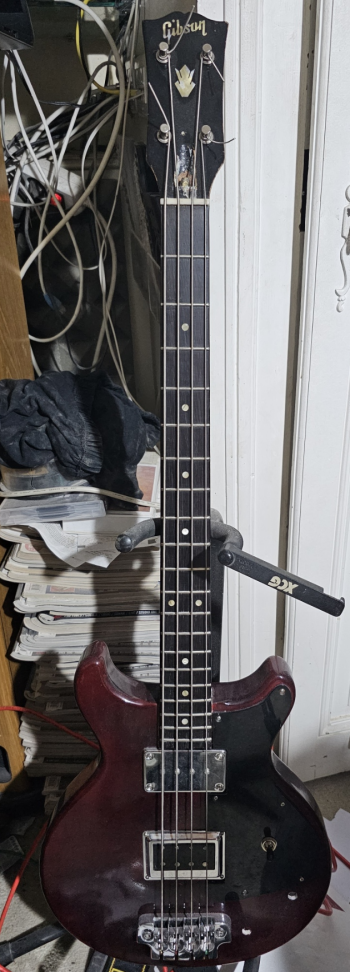Guitars
Gibson introduced what we'd now recognise as an SG in 1961 as the successor to the "Les Paul", though they
changed it's name to SG (Solid Guitar) in 1963, possibly due to Les Paul's low opinion of the
new body shape or his forthcoming divorce from Mary Ford.
Mine is an SG Special from around 1970 with Kluson "3 in a row" machine heads, mahogany neck and body,
rosewood fingerboard and the famous P90 single coil "soap bar" pickups.
The Special was discontinued in 1971, though re-issues are now available from the
Gibson custom shop , including the
Pete Townsend SG Special, which is a very similar model to mine.
- Neck radius - 12"
- Width at nut - 19⁄16"
- Scale length - 249⁄16" (24.563")
- Neck Profile - D
- Neck profile depth (Frets 1 & 12) - 20.0mm - 25.2mm
![]() Gibson Guitars on the web
Gibson Guitars on the web
![]() Gibson Guitar and s/n info
Gibson Guitar and s/n info
![]() Gibson SG dedicated site
Gibson SG dedicated site
![]() Gibson SG Specials at Reverb
Gibson SG Specials at Reverb
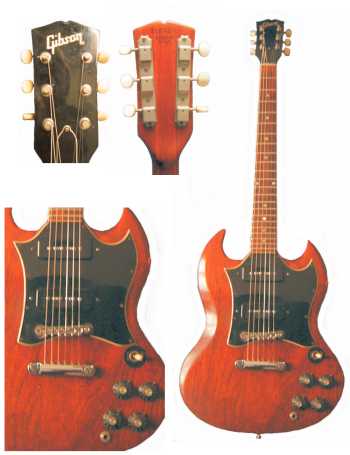
Fender introduced the top of the range Jaguar in 1962 as an upgrade to the Jazzmaster. It used the same body shape as the Jazzmaster as well as the bridge and vibrato unit.
The differences were the new chrome plates, the 22 frets and its 24 inch scale length as opposed to the standard 25.5. The jaguar had newly designed pick-ups in an attempt to reduce noise, as well as the most complex electronics seen on a Fender guitar up until that date.
My version is an amalgam of a 1965 neck and a 1963 (originally sunburst) body with original pickups, scratchplate, chrome and tail-piece, but with replica machine heads, electrics and a Mastery bridge which uses 3/8" (9.5mm) thimbles.
Neck heel stamp - 1 (Jaguar) MAY 65 (May 1965) B (1⅝" width at nut)
- Neck radius - 71⁄4"
- Width at nut - 15⁄8"
- Scale length - 24"
- Neck Profile - D
- Neck profile depth (Frets 1 & 12) - 19.9mm - 24.7mm
![]() Purchase Jaguar switch plate shim on Reverb
Purchase Jaguar switch plate shim on Reverb
![]() Fender Jaguar guitars on the web
Fender Jaguar guitars on the web
![]() Fender Custom Shop Jaguar guitars
Fender Custom Shop Jaguar guitars
![]() Fender Custom Colors
Fender Custom Colors
![]() Fender Guitar and s/n info
Fender Guitar and s/n info
![]() 1962-1968 Fender Jaguar info
1962-1968 Fender Jaguar info
![]() Fender Jaguar reference info
Fender Jaguar reference info
![]() Fender Jaguar pickup circuitry
Fender Jaguar pickup circuitry
![]() Mastery Offset replacement bridge for Jaguar/Jazzmaster
Mastery Offset replacement bridge for Jaguar/Jazzmaster
![]() Offset Guitars - photos, history & setup
Offset Guitars - photos, history & setup
![]() Staytrem Tremolo Collet Fitting
Staytrem Tremolo Collet Fitting
![]() Staytrem Tremolo Arm Insertion
Staytrem Tremolo Arm Insertion
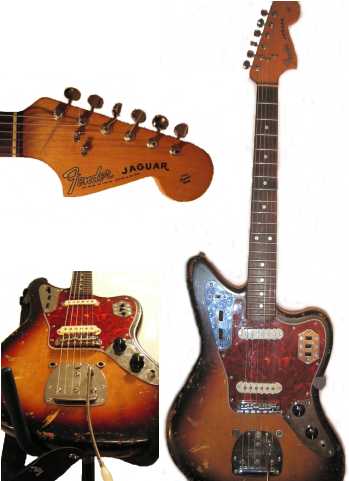
This is a second iteration SG 1500 from 1982. The Yamaha SG 1500 has a neck through body design, push/push pots for coil splitting the humbuckers and a fast playing thin neck with chevron inlays.
Body: The body is 7 pieces in all, the 3 piece neck is one with the body, it is mahogany/maple with a carved top, tobacco (old sunburst) finish, w/b/w binding, double cutaway and it has a belly contour. This SG 1500 weighs 4.6kg.
Neck: The neck-through-body design is made up of 2 pieces of maple with a mahogany center piece, it has a slim 60s carve, bound rosewood fingerboard, 22 frets, chevron inlays, bone nut and multi ply w/b/w bound headstock.
Pickups/Hardware: It has 2 after-market Seymour-Duncan humbuckers (SH-4 & SH-2N), coil splitting tone knobs, 2 volumes, 3 way toggle, gold plated tune-o-matic style bridge with hard engraved tailpiece, gold Kluson style tuners with green keystones, bone nut and the original gold easy grip knobs.
- Neck radius - "
- Width at nut - 1.675"
- Scale length - 25"
- Neck Profile -
- Neck profile depth (Frets 1 & 12) -
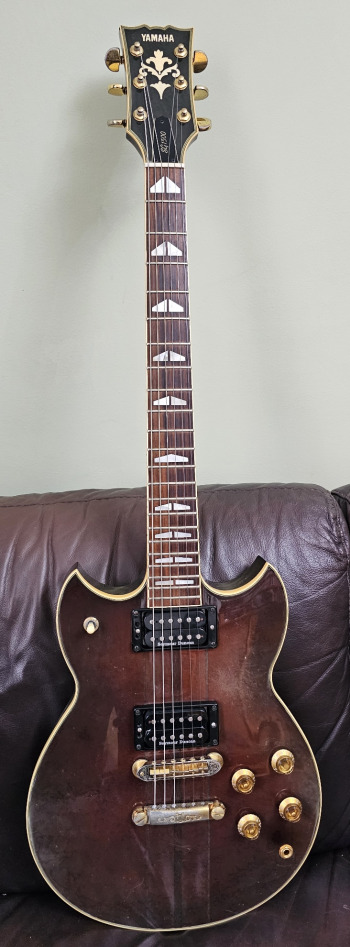
The Gibson Moderne is an electric guitar model prototyped by Gibson in 1957. It was designed alongside the Flying V and Explorer-"Futura" as part of a stylistically advanced line of electric guitars. However, unlike the Flying V and Explorer, the Moderne was not put into production at the time.
Because few prototypes were made in the 1950s, and no authenticated example is currently known, the hypothetical 1958 Moderne has been called the "mythical great white whale" or "holy grail" of collectible guitars
By the mid-1950s Gibson Guitar Company had lost considerable market share to rival Fender's Telecaster and Stratocaster models and created three modernistic solid-body guitar concepts in an attempt to strike back. On June 27, 1957, Gibson President Ted McCarty filed three designs with the United States Patent Office which would come to be called "Flying V", "Explorer", and (unofficially, by later historians) "Moderne". The design patents were issued on January 7, 1958; however, after getting an exceedingly poor reception at NAMM 1957, Gibson decided not to produce the Moderne. There is only a vague mention of "Mod. Guitars" on a shipping list, which some argue applies to Explorers. Gibson engineer Rendall Wall (and later co-founder of Heritage Guitars) played one in the early 1960s for a local performance of Bye Bye Birdie. Wall recounted that he got it out of Gibson's "morgue", and that he could have bought it for $50: it was so ugly that nobody wanted it. He returned it after the show, saying he was more a country player than a rock and roll player.
Some Gibson employees said that no prototypes were ever made, others, including Ted McCarty, say that a few were made, but nobody knows where they went. Some Gibson employees from that time also say that two men took parts being used to make the Moderne prototypes and assembled some outside the factory
They were "re-issued"" by Gibson in 1980 at the NAMM show in Atlanta as part of the "Heritage Series" and later produced in Korea by Epiphone.
Modernes have the usual Gibson combination of two humbuckers (I've installed a pair of Curtis Novak Humbuckers), adjustable Tune-o-Matic bridge (mine is a TonePros T3BT-G) and stop tailpiece. Unlike most 2-pickup Gibsons, the Moderne has a single master tone control rather than separate neck and bridge pots. I've used push/pull pots to split the hubuckers into single coils using this schema.
Because of their very limited production and forward design, Gibson Modernes are highly sought after by collectors.
- Neck radius - 14"
- Width at nut - 13⁄4"
- Scale length - 243⁄4"
- Neck Profile - D
- Neck profile depth (Frets 1 & 12) - 19.9mm - 24.7mm
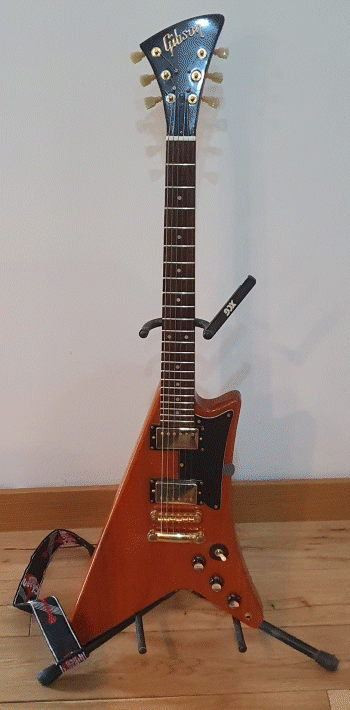
Mine is a 1982 model made in Japan. Basically just a Fender Precision copy with a Sen ash body and maple fingerboard.
I did originally change the pick-ups for some Seymour Duncan SPB-3s , but they were just far too distorted for my liking, so now I've bought some Curtis Novak PB-Vs which I like a lot more.
- Neck radius - 71⁄4"
- Width at nut - 42.5mm
- Scale length - 34"
- Neck Profile - D
- Neck profile depth (Frets 1 & 12) - 20.8mm - 25.2mm
- Neck screw length - 47mm

Mine is a 1960 model made in USA. This has the same body shape as a Les Paul Special/Junior DC from the same era (my favourite body shape). It came to me as a hacked about carcass body and neck and I've tried to sympathetically refurbish it without modifying it too much, though it had been routed for a second pickup, a feature which I've kept. All new pickups ar from Curtis Novak, an EB-0 for the neck pickup and a Bisonic clone BS-DS for the new bridge pickup.
The replacement bridge is a Hipshot Supertone 5G410C with the following spec. The Hipshot bridge setup procedure is here.
- Neck radius - 10"
- Width at nut - 111⁄16"
- Scale length - 301⁄2"
- Neck Profile - Fat C
- Neck profile depth (Frets 1 & 12) - 22.6mm - 27.0mm
![]() Reverb article on the original EB0 bases
Reverb article on the original EB0 bases
![]() Original EB0s on sale at Reverb
Original EB0s on sale at Reverb
